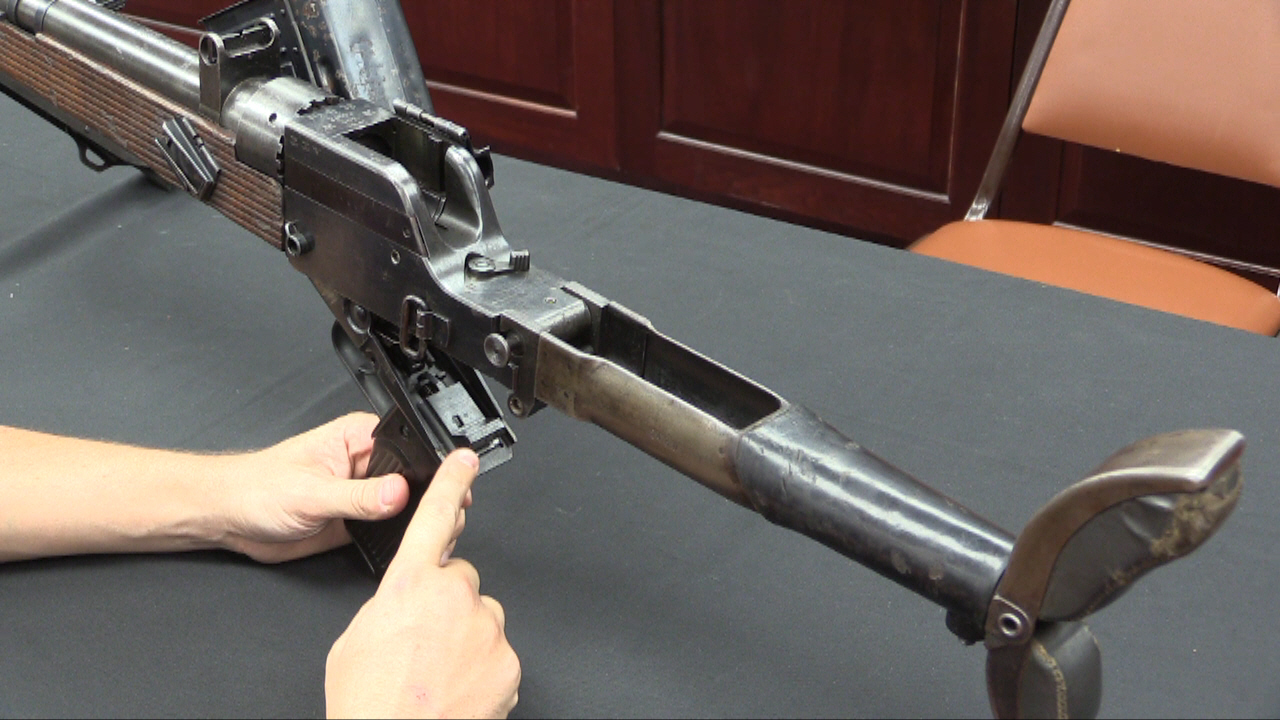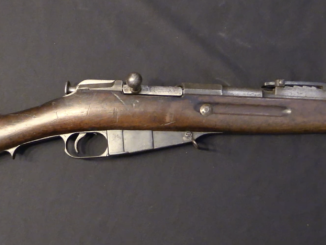The Ortgies is a pistol whose interested aspects are often overlooked on the assumption that it is just another identical .32 ACP blowback pistol. Well, it is that – but it is also more.
Mechanically, the Ortgies has a rather unusual grip safety mechanism that is quite different from what we expect to see today. It is also interesting in that the .32 and .380 versions differ only in the easily-interchanged barrel – even the magazines are marked for both calibers.
However, the most interesting part of the Ortgies story (in my opinion) is its production. In less than 5 full years (1919-1923), close to a half million of these guns were made, primarily by an industrial subsidiary of the German government. The guns were in large part a work program, creating export goods which could bring desperately needed hard currency into Germany to counteract the economic devastation of the Versailles treaty.
Have a look at the video and you may come away with a newfound appreciation for the humble Ortgies, like I did!
Examples in this video:




Thank you for this. I inherited a .32 ACP Ortgies from my maternial grandmother and wish I knew more about its history. At some point one of the grip panels was replaced with a piece of hand-carved wood! I’ve shot it, and even bought some replacement springs for it (while I was making an order with Wolfe’s anyway).
Oops; just checked, and discovered that both wooden grip panels are actually factory original. Not sure where I got the idea that one was a replacement. Could be thinking of another old gun I have.
Oh, and the magazine is marked only 7.65, on the bottom. The grips have the cat logo. Rather, one of them does. The other has a small hole which I at first thought was a screw hole. After seeing in the video how the grips are actually attached I’m not sure what that’s for.
This is an excellent and common sense design for most common calibres of the time period. As Ian says, Mr.Ortgies had truly lucky hand; he had applied, with help of his designer Mr.Brauning “KISS” role to its ultimate extent.
Just wondering about the following owner of manufacturing right this being Deutsche Werke Aktiongesselschaft. Does it have any connection with Deutsche Waffen u. Munitionen (Ludwig Loewe) in Berlin?
Deutsche Waffen u. Munitionen (Ludwig Loewe)
DWM or Deutsche Waffen- und Munitionsfabriken, what you write means simply German Weapons & Ammunition.
“Just wondering about the following owner of manufacturing right this being Deutsche Werke Aktiongesselschaft”
Go here: http://www.ortgies.net/ and click Click here to view, to see some history about Ortgies automatic pistol, I don’t read it yet, so I don’t know whatever it has or has not answer to your question.
“Does it have any connection”
Probably not, this site: http://deutschewerkekiel.jimdo.com/deutsche-werke-kiel/chroniken-aller-deutscher-werke/ does NOT say about DWM or Berlin-Karlsruher Industriewerke AG (name used after Armistice), however note that say about Deutsche Werke Berlin, Spandau und Haselhorst. DWM and Spandau were two different factiores (DWM was in Berlin-Reinickendorf and Spandau in Berlin-Spandau).
The Ortgies is also memorialized in Great Literature — would never have heard of it until I saw it named as the suicide weapon in J.D. Salinger’s story “A Fine Day for Bananafish.”
Alleged also to be supremely accurate — several national and international championships were won by marksmen shooting with Ortgies pistols.
Did the Germans have a thing for grip operated safeties? The operation of the Ortgies safety looks very similar to the Jäger safety from yesterday. Are the other pistols from this era with a similar design? Also do you see any connection between this style of safety and the squeeze to cock design of the H&K P7?
“design of the H&K P7”
In terms of placement P7 solution – element to squeeze in front – is similar to earlier German automatic pistol – Schwarzlose Model 1908:
https://en.wikipedia.org/wiki/Schwarzlose_Model_1908
“Did the Germans have a thing for grip operated safeties?”
Marinepistole Luger 04 has grip safety, but it was abandoned in Pistole 08, so they probably consider that as not necessary in military automatic pistol.
On the other hand, on the other hand Swiss Luger in all iterations (1900, 1900/06, 1906/29) retained grip safety. In case of personal automatic pistol made in Germany I have no simple answer – some models of pistol have grip safety, other don’t have.
No slide rails on this pistol ? I didn’t see how they got around this .
Looking and fully disassembled photo here:
http://www.vestpockets.bauli.at/archiv/archiv.htm
it looks for me that slide contacts with frame near back end(?, I’m not sure)
Just counted German pistol makers in the chart – there is 11 of them. Deutsche Werken is first, DWM is not present.
This list is incomplete, it would be extreme hard to make complete list even if restricted to GERMANY and POCKET AUTOMATIC PISTOL category.
DWM produced 7,65mm Browning (.32 Auto) automatic pistol, see photo here:
http://parallaxscurioandrelicfirearmsforums.yuku.com/topic/39740#.V2PC4sajEmE
Zhuk name it simply DWM. 7,65. other sometimes Model 1922 or Model 1923 (not sure – they are differ or not?)
Zhuk description: close Browning 1910 copy, first appearance 1923.
“Deutsche Werke” has nothing to do with DWM.
Deutsche Werke was the attempt to save as much as possible from the former arsenals located at Spandau under a civilian company.
The Ortgies pistols did not fall under the “military handgun” rule (9 mm caliber or 100 mm barrel) and therefore were considered civilan products from a Versailles Treaty perspective.
Very obviously because 9mm Parabellum is a bit overkill for enounters with muggers armed with knives… Well I am assuming that there was a risk of dying due to infected bullet wounds!
Yes, it looks that way. Thanks for responses from you and Daweo.
““military handgun” rule (9 mm caliber or 100 mm barrel) and therefore were considered civilan products from a Versailles Treaty perspective”
To dodge this limit, Luger automatic pistol made for export to Finland has 95-mm or 98-mm barrel and were chambered for 7.65x21mm
http://www.jaegerplatoon.net/PISTOLS1.htm
Longer replacement barrels (120mm) were later produced in Finland.
8x60mm S cartridge: https://en.wikipedia.org/wiki/8×60mm_S was created specially to go around NO MILITARY CARTRIDGE rule, it was designed as ballistic copy of 7.9×57 and in way that weapon firing 7.9 can be easily reworked to fire 8×60 S cartridge.
I found A lot of Ortgies pistols pistols for sale at Milwaukee gun shows. I was told that a lot of them were offered as top prize on “pull tab” gambling games in bars in the late 1920’s and 1930s.
Some detailed info here; http://unblinkingeye.com/Guns/Ortgies/ortgies.htmlhttp://www.njgunforums.com/forum/index.php/topic/34000-ortgies-pocket-pistol-disassembly/
Very well designed pistol with unique features in; Lateraly working disconnector, Grip safety, Striker attachment and take down.
Japanese Hamada pistols and Spanish Alkar seem borrowed some of these features.
Sorry, documents seem not working. Please retry.
Source 1;http://unblinkingeye.com/Guns/Ortgies/ortgies.html
Source 2;http://www.njgunforums.com/forum/index.php/topic/34000-ortgies-pocket-pistol-disassembly/
One of the coolest parts about this site is learning about weird little ideas that never quite caught on (often for bloody good reasons!)
It really gives you some perspective on how innovation and technological development works.
“how innovation and technological development works.”
Quite ironically gunpowder was invented during experiments which objective was to make life-lengthening elixir – http://www.livescience.com/7476-gunpowder-changed-world.html
And so was discovery of twisted grooves in barrel influence on stability of projectile – merely by accident due to manufacturing error. The supporting science came afterwards.
Though I have found lots of info about this fascinating pistol, ónly one thing I never learned: how many bullets capacity it has.